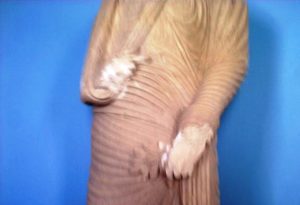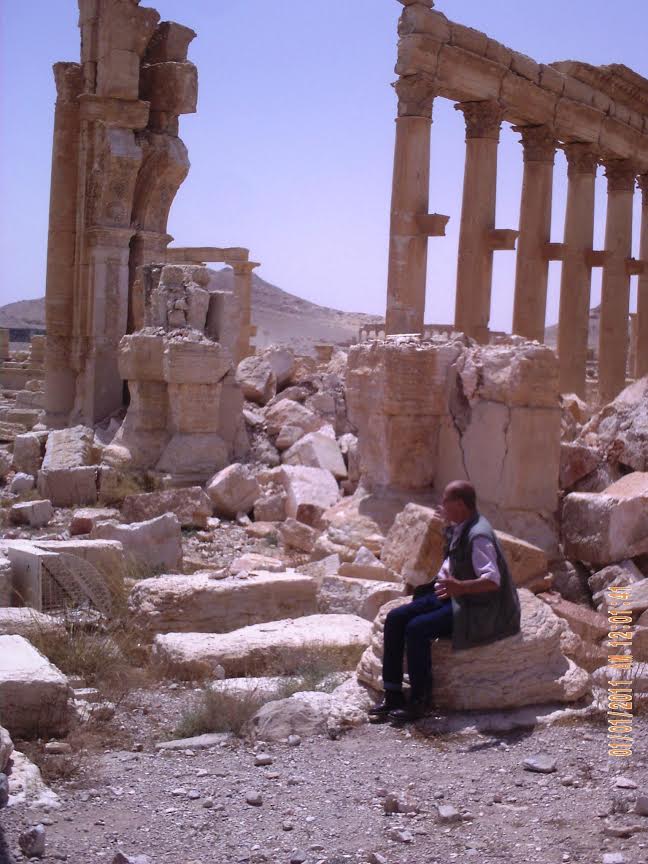How 100 Syrians, 200 Russians and 11 Dogs Out-Witted ISIS and Saved Palmyra
SYRIA IN CONTEXT, 27 Jun 2016
Franklin Lamb – TRANSCEND Media Service
Something just didn’t feel quite right to Syrian army brass as they penciled in final plans to liberated Palmyra in early March 2016 and as they debated how best to drive Daesh (ISIS) out of Palmyra and deep into the surrounding unwelcoming Syrian desert. This, according to army intelligence officials and commanders who this week briefed this observer at various locations around Palmyra.
Some generals were puzzled. “Why did Daesh not do even more damage at the ancient ruins, given their widely broadcast iconoclasm and their targeting as heresy ancient pre-Islamic sites,” one officer remembers asking his colleagues. Daesh (ISIS) certainly had the means and their perverted Koranic motivation to destroy the whole ancient ruins area. This puzzlement was widely held by officials and military strategists who increasingly wondered what was really going on as it became evident that Daesh’s military positions at Palmyra were untenable and they surely would be driven out. Many archeologists and others wondered the same thing as the horrors shown on ISIS U-tube videos began to appear on the Internet.
The Syrian army was soon to learn the answer to their question of why didn’t the Islamic State (Daesh) do more damage among the acres of ruins?
A bit of background. Before waging its final assault to re-take Palmyra, Damascus issued orders to the army not to shell near the ruins. The Syrian air force was similarly instructed not to bomb in the close-in area. So the army, at the cost of losing some troops, did not invade from the south into the area of the ancient ruins. Rather they surrounded the whole area and fought close-in street battles, mainly in the “modern” city area. “Tadmor, (Palmyra) was taken piece by piece to avoid damaging the ruins”, one officer who took part in the fighting explained to this observer.
It is now known why sparing the “ruins area” from close-in fighting may have been alright with IS, for what they had carefully planned, as discussed below, was a deadly surprise for the anticipated and hoped for more than for 1000 Syrian troops they calculated would soon arrive and advance into the ruins.
ISIS had correctly assumed that the Syrian military would not bomb Palmyra’s National Museum, Syria’s second most tourist visited collection of antiquities after the National Museum in Damascus. For this reason IS housed key leaders and its Sharia court and archives among the remaining statues inside Palmyra’s museum and were fairly safe during their 8 month occupation of the “Bride of the Desert”. This, as they methodically chiseled off the faces and hands of each of the 74 statue heads, including those in what people here refer to the Museum’s “Head Room.” It was in the basement of the museum that ISIS planned for the fate of the acres of our cultural heritage ruins.
These photos taken by this observer on 6/22/2016 at the Palmyra Museum illustrate the ISIS results of chiseling off every face and hand (I counted a total of 74) on statues they found in the Museum.
ISIS damage to the Palmyra Museum and its content would have been much worse according to eyewitnesses had it not been for the work of Syria’s Directorate-General of Antiquities and Museums (DGAM) led by Dr. Maamoun Abdul Karim. “Dr. Maamoun” as he is affectionately known is Syria, is an international patriot to whom all people of good will are indebted for his indefatigable labor on behalf of all of us to preserve, protect and restore our shared cultural heritage. Every Abdul-Karim initiative since the start of the current crisis was solidly implemented by DGAMS competent staff of hundreds, as well as the frequent close-in support of the Syrian army and crucially, the local population across Syria, many of whom this observer has been honored to meet the past few years. Together they were able to protect more than 80% of the exhibits at Palmyra’s museum. Their most recent mission of transporting a large truck full of Museum contents was undertaken at great personal risk and less than 24 hours before ISIS invaded and surrounded the city.
There has been much understandable confusion and also a bit of misinformation about the degree of damage to Palmyra’s archeological sites. Contrary to many media reports, only five percent of the area of our cultural heritage archeological treasures was damaged by ISIS.
Experts at Palmyra have recently formed three units specializing in engineering, archeological evaluations and restoration of damage artifacts. As noted above, it is widely believed here that 95% of Daesh caused damage can and will be restored.. Even a higher percentage can be restored some archeologists working here estimate. And 95% of all the ruins were untouched. Why?
These assertions are not meant to minimize the massive cultural heritage crimes that ISIS committed, including but not limited to the Arc de Triumph, Temple of Bel and, Sella ( Sella being the central part of the temple where the statue of the God Bel, was located ) and other archeological sites visited by this observer in the company of experts from Syria’s Directorate-General of Antiquities and Museum (DGAM) including my new friend Mohammad Assa’ad, the much cherished son of the hero of all of us, Khaled Assa’ad, who on August 18, 2015 was brutally murdered near the Palmyra Museum where he had labored for decades. Khaled Ass’ad was accused by ISIS of being an “apostate’ for refusing to give them, even under torture, the information they were seeking about the whereabouts of certain artifacts.
The nagging question persisted into March 2016. Why the limited destruction? What was ISIS up to? Some archeologists and military strategists had been wondering and watching since the ISIS occupation and atrocities began. Another question being asked was why at locations such as the Arc de Triumph, Temple of Bel and, Sella, ISIS did not damage or remove the chunks of the blown up columns and structures. They were left at the base of the structure and ISIS must have been aware that despite its iconoclastic destructions, the columns and structures could be put back together. “We felt something was wrong with this picture” one expert who has worked at Palmyra for the past two decades explained. “Did Daesh (ISIS) explode certain sites mainly for publicity and was it not interested to cause more lasting destruction and erase the surrounding area?” The gentleman’s use of the word, “erase” was soon to have more significance than this observer initially attached to his word choice.
Visiting UNESCO officials from Paris recently engaged in very useful discussions here, according to one participant, of two often misunderstood concepts, restoration vis a vis rebuilding. Syria plans restoration at Palmyra which uses the original matrix fragments and not rebuilding which suggests using materials from elsewhere. UNESCO agrees with DGAM and has promised major help once security conditions allow. So have many others internationally.
Why such optimism? Is it misplaced? Experts here think not. As the photo below makes clear, at virtually all the sites that ISIS bombed, the large pieces of the fallen structures are on the ground. And they can and will be restored to their original position.
The photo above, taken 6/22/2016 by Mr. Wael al Hafian of the Homs Directorate of Antiquities, illustrates that at ISIS bombed structures, the broken archeological pieces are all still at the site. This is crucially important. The whole ruins area is being guarded by the Syrian army. One very interesting and charming Japanese gentleman excitedly exclaimed that by employing recently developed technology, similar in some respects to what Japanese experts used to “look inside” Egyptian pyramids at few years back, he has ‘seen’ in the pile of rubble shown above approximately 325 pieces of the bombed arch and that every piece can be put back exactly in its place. This is very good news and one hopes that the gentleman from an Osaka University is correct.
So what was the Daesh plan for Palmyra and what went wrong?
We now know that any chance for restoration of our cultural heritage is not what ISIS had in mind as it prepared to evacuate Palmyra. Many details have emerged about their pre-liberation plans for the sites.
As soon as ISIS arrived to Palmyra on May 20, 2015 and in the coming days, the local population with some exceptions such as the family of the former Director of Palmyra Antiquities and Museums, Khaled Ass’ad fled by any means they could. Many evacuated with the Syrian army.
Syrian army intelligence admits that it did not have many agents in the area, whose remaining population of approximately 500 ISIS tightly controlled. But they did receive some reports about seemingly odd middle of the night activity among the ruins. The activity, locals sources claimed, increased toward the end of the eight months of ISIS occupation.
To shorten a long story, this observer can reliably report that by piecing together bits of information and evaluating rumors, Syrian army intelligence discovered, just a couple of days before it intended to enter in force into the area of ruins, that ISIS had developed a very elaborate plan, using some of the latest American technology, one archeologist who has worked for many years at Palmyra explained. Another source told this observer that no, there was nothing used by ISIS that the Syrian and Russian ordnance disposal specialists were unfamiliar with. But the breadth and detail of the wiring and explosives ISIS placed hidden among the ruins were found to be very sophisticated. The ISIS plan which was also apparently referenced in a document later recovered from the Museum was dubbed “Erase.” (“Mahaqa” in Arabic). ISIS planned to “Erase” the whole area of our ancient ruins and ISIS hoped to kill at least 1000 Syrian troops who they assumed would be among the ruins when they were detonated.
The rumors from some locals turned out to be quite accurate with respect to unusual nocturnal activates among the columns and ancient structures. ISIS laid what must have been a few miles of wires directly connecting virtually every column and structure of ancient Palmyra to massive amounts of buried explosives that included more than 4000 bombs among the ruins and another 1000-plus in Palmyra town. Using technology and triggering devices some claim were not seen to be used earlier, the whole area was intended by ISIS to be “Erased” by a massive explosion, and as noted above hopefully killing large numbers of Syrian soldiers at the same time.
More details of the ISIS “Erase” project were uncovered when army investigators listened to local sources and began to poke around the ruins. Long story made short, Syrian and Russian experts discovered that ISIS planned to trigger “Erase” at their moment of choosing by employing one of two means. The ISIS Plan A was to detonate the massive explosions of “Erase” by using a mobile phone from as far away as between 5 and 10 kilometers to trigger the massive explosion. A backup Plan B triggering method was tied into landline phone lines. Discovered only a short period before the conflagration was likely to be unleashed, arriving Syrian forces acted fast and the first measure they took was to have the two Syrian phone services Syriatel and MTN shut down all the phone lines in and around Palmyra. “Erase” was disabled unless ISIS had a Plan C. If so, it did not work either.
The dangerous and tedious unexploded ordnance disposal work began in earnest on March 29, 2016 and continued until April 30, 2016. A week later on May 5th Russian symphony performed in the amphitheater where not too long ago 22 Syrian soldiers were hanged-one each on a massive column. Still visible is one of the hanging roads tied at the top of one column. The next day, May 6th, Syria used the same site to celebrate Martyr’s Day during a 7 to 10 p.m. ceremony.
The dangerous work of clearing the unexploded ordnance was performed by many to date unsung heroes; among them are 100 Syrian and 200 Russian unexploded ordnance specialists and 11 Russian explosive detecting dogs. Some robots were all deployed as part of the massive around clock bomb clearing operation.
At the end of the intense 30 days of heroic work, which claimed the lives of two soldiers and wounded others, no fewer than 4000 booby-trap bombs were defused and removed from among our cultural heritage ruins at ancient Palmyra.
According to the Syrian General who commanded the whole neutralization of the ISIS “Erase” project, and who generously gave these observer hours of his and his staff’s time, all of Palmyra and the close-in surrounding area are now cleansed of bobby-traps and are safe.
The General proclaimed just this week that Palmyra and our cultural heritage sites here are ready and waiting to again receive foreign friends.
____________________________________
Franklin Lamb is doing research in Syria and Lebanon and volunteers with the MSRCL and the Sabra-Shatila Scholarship Program. His latest book, Syria’s Endangered Heritage is available on Amazon/Kindle. He is reachable c/o fplamb@gmail.com
This article originally appeared on Transcend Media Service (TMS) on 27 Jun 2016.
Anticopyright: Editorials and articles originated on TMS may be freely reprinted, disseminated, translated and used as background material, provided an acknowledgement and link to the source, TMS: How 100 Syrians, 200 Russians and 11 Dogs Out-Witted ISIS and Saved Palmyra, is included. Thank you.
If you enjoyed this article, please donate to TMS to join the growing list of TMS Supporters.

This work is licensed under a CC BY-NC 4.0 License.



